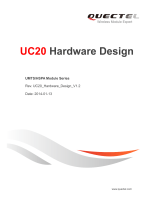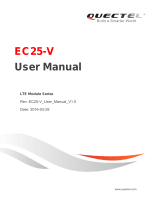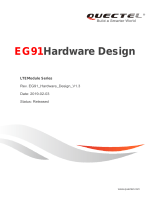Page is loading ...

G2
Hardware User Guide
Issue 2.0
Date2019-02-13
Neoway Product Document

G2
Hardware User Guide
Copyright © Neoway Technology Co., Ltd
i
Copyright © Neoway Technology Co., Ltd 2019. All rights reserved.
No part of this document may be reproduced or transmitted in any form or by any means without prior
written consent of Neoway Technology Co., Ltd.
is the trademark of Neoway Technology Co., Ltd.
All other trademarks and trade names mentioned in this document are the property of their respective
holders.
Notice
This document provides guide for users to use G2.
This document is intended for system engineers (SEs), development engineers, and test engineers.
THIS GUIDE PROVIDES INSTRUCTIONS FOR CUSTOMERS TO DESIGN THEIR APPLICATIONS.
PLEASE FOLLOW THE RULES AND PARAMETERS IN THIS GUIDE TO DESIGN AND COMMISSION.
NEOWAY WILL NOT TAKE ANY RESPONSIBILITY OF BODILY HURT OR ASSET LOSS CAUSED BY
IMPROPER OPERATIONS.
THE INFORMATION IN THIS DOCUMENT IS SUBJECT TO CHANGE WITHOUT NOTICE DUE TO
PRODUCT VERSION UPDATE OR OTHER REASONS.
EVERY EFFORT HAS BEEN MADE IN PREPARATION OF THIS DOCUMENT TO ENSURE ACCURACY
OF THE CONTENTS, BUT ALL STATEMENTS, INFORMATION, AND RECOMMENDATIONS IN THIS
DOCUMENT DO NOT CONSTITUTE A WARRANTY OF ANY KIND, EXPRESS OR IMPLIED.
Neoway provides customers complete technical support. If you have any question, please contact your
account manager or email to the following email addresses:
Website: http://www.neoway.com

G2
Hardware User Guide
Copyright © Neoway Technology Co., Ltd
ii
Contents
1 About G2 .................................................................................................... 1
1.1 Overview ...................................................................................................................................... 1
1.2 Block Diagram .............................................................................................................................. 1
1.3 Specifications ............................................................................................................................... 2
2 Pad Layout and Pin Definition ................................................................... 4
2.1 Pad Layout ................................................................................................................................... 4
2.2 Pin Definition ................................................................................................................................ 5
3 Application Interfaces ................................................................................ 7
3.1 Power Supply ............................................................................................................................... 7
3.1.1 VBAT .................................................................................................................................... 7
3.1.2 VBACKUP ........................................................................................................................... 7
3.1.3 Work Modes ........................................................................................................................ 7
3.2 UART ............................................................................................................................................ 8
3.3 I2C ................................................................................................................................................ 9
3.4 1PPS ............................................................................................................................................ 9
4 Antenna Interface .................................................................................... 10
4.1 Ceramic Patch Antenna ............................................................................................................. 10
4.2 PCB Design ................................................................................................................................ 10
5 Electrical Feature and Reliability ............................................................. 12
5.1 Electrical Features ..................................................................................................................... 12
5.1.1 Extreme Operating Voltage ............................................................................................... 12
5.1.2 Recommended Operating Voltage .................................................................................... 12
5.2 Temperature ............................................................................................................................... 13
5.3 ESD Protection ........................................................................................................................... 13
6 Mechanical Features ............................................................................... 14
6.1 Dimensions ................................................................................................................................. 14
6.2 Label/Apperance ........................................................................................................................ 15
6.3 Packaging ................................................................................................................................... 15
6.3.1 Tape & Reel Packaging ..................................................................................................... 15
6.3.2 Mositure-Sensitive ............................................................................................................. 17
7 Application Design and SMT ................................................................... 18
7.1 G2 Foot Print .............................................................................................................................. 18
7.2 Recommended Footprint ............................................................................................................ 19
7.3 Stencil ......................................................................................................................................... 19
7.4 Solder Paste ............................................................................................................................... 19
7.5 Reflow Profile ............................................................................................................................. 20
8 Safety Recommendations ....................................................................... 22
A Abbreviation ............................................................................................. 23

G2
Hardware User Guide
Copyright © Neoway Technology Co., Ltd
iii
Table of Figures
Figure 1-1 Block diagram ................................................................................................................... 2
Figure 2-1 G2 pin definition (top view) ............................................................................................... 4
Figure 3-1 UART connection .............................................................................................................. 9
Figure 3-2 1PPS timing ...................................................................................................................... 9
Figure 6-1 G2dimensions (Unit: mm) ............................................................................................... 14
Figure 6-2 G2label ........................................................................................................................... 15
Figure 7-1 G2 foot print (bottom view) ............................................................................................. 18
Figure 7-2 Recommended PCB footprint (top view) ........................................................................ 19
Figure 7-3 Temperature curve .......................................................................................................... 20

G2
Hardware User Guide
Copyright © Neoway Technology Co., Ltd
iv
Table of Tables
Table 1-1 Version and bands .............................................................................................................. 1
Table 2-1 IO types .............................................................................................................................. 5
Table 2-2 Pin definition ....................................................................................................................... 5
Table 3-1 Power status, clock status, and current in different work modes ....................................... 8
Table 4-1 G2 ceramic patch antenna ............................................................................................... 10
Table 5-1 G2 extreme operating voltage .......................................................................................... 12
Table 5-2 G2recommended operating voltage ................................................................................. 12
Table 5-3 Temperature feature ......................................................................................................... 13
Table 5-4 G2 ESD feature ................................................................................................................ 13

G2
Hardware User Guide
Copyright © Neoway Technology Co., Ltd
v
About This Document
Scope
This document is applicable to G2 series.
It defines the features, indicators, and test standards of the G2 module and provides reference for the
hardware design of each interface.
Audience
This document is intended for system engineers (SEs), development engineers, and test engineers.
Change History
Issue
Date
Change
Changed By
1.0
2018-08
Initial draft
Zhuo Jianzheng
2.0
2019-01
Modified some parameters
Changed pin names of I2C function
Deleted sleep mode
Zhuo Jianzheng
Conventions
Symbol
Indication
This warning symbol means danger. You are in a situation that could cause fatal
device damage or even bodily damage.
Means reader be careful. In this situation, you might perform an action that could
result in module or product damages.

G2
Hardware User Guide
Copyright © Neoway Technology Co., Ltd
vi
Means note or tips for readers to use the module
Related Documents
Neoway_G2_Datasheet
Neoway_G2_Product_Specifications
Neoway_G2/G7A_Receiver_Command_Mannual
Neoway_G2_EVK_User_Guide

G2
Hardware User Guide
Copyright © Neoway Technology Co., Ltd
1
1 About G2
G2 is a GNSS module that supports BDS B1, GPS L1, and GLONASS L1. It adopts a unified chipset
integrating baseband and RF and embeds LNA and ceremic patch antenna. This architecture
facilitates the application design and reduces the cost. It is an optimal navigation solution to demands
for high sensitivity, low power consumption, and low cost in different navigation devices
1.1 Overview
G2 series including the following variants and band configurations.
Table 1-1 Version and bands
Module
Variants
GPS
BDS
GLONASS
Support GAGAN
G2
G2-B1
√
√
G2-D1
√
√
√
1.2 Block Diagram
G2 consists of the following functional units:
GNSS baseband
RF front end components
RTC
Peripheral interfaces

G2
Hardware User Guide
Copyright © Neoway Technology Co., Ltd
2
Figure 1-1 Block diagram
1.3 Specifications
Parameter
Description
Spec
Remarks
Min.
Typ.
Max
Unit
Positioning precision
(open air)
Horizontal
<2
m
Elevation
<4.5
m
Speed precision
<0.1
m/s
Channel quantity
Capturing
72
Tracking
72
TTFF
(@-130dBm)
Cold start
<32
s
Hot start
1
s
Recapture
1
s
Sensitivity
Cold start
-148
dBm
Hot start
-156
dBm
Recapture
-160
dBm
VBAT VBACKUP
1PPS
UART_RXD
UATR_TXD
SAW
LNA
SAW
PATCH
ANTENNA
Cortex-
M3
ROM
RAM
FLASH
PM
GNSS Baseband
Engine
Peripheral
Controller I2C_SCL
I2C_SDA

G2
Hardware User Guide
Copyright © Neoway Technology Co., Ltd
3
Tracking
-162
dBm
Baud rate
4800
9600
2560400
bps
9600bps by
default
Update frequency
1
10
Hz
1Hz by default
Operating voltage
VBAT
2.7
3.3
3.6
V
VBCKUP
1.4
3.3/3.0
3.6
V
Current
(@instrument)
Capturing
30
mA
3.3 V
Tracking
28
mA
3.3 V
Idle
10
μA
3.3 V

G2
Hardware User Guide
Copyright © Neoway Technology Co., Ltd
4
2 Pad Layout and Pin Definition
There are 13 pins on G2 and their pads are in LCC package.
2.1 Pad Layout
Figure 2-1 shows the pad layout of G2.
Figure 2-1 G2 pin definition (top view)
POWER GND 1PPS UART RESERVED
VBAT
I2C_SDA
GND
VBACKUP
1PPS
RESERVED
I2C_SCL
GND
UART_TXD
UART_RXD
GND
GND
GND
1
2
3
4
5
6
7
8
9
10
11
12
13

G2
Hardware User Guide
Copyright © Neoway Technology Co., Ltd
5
2.2 Pin Definition
Table 2-1 lists the IO types
Table 2-1 IO types
IO types
DO
Digital output, COMS logic level
DI
Digital input, COMS logic level
PI
Power input
DC feature description
P1
Power type of digital IO interface
3.3V:
VIH=2.6V~3.6V,
VIL= -0.3V~0.6V
VOH=2.9V~3.3V,
VOL=0V~0.4V
Table 2-2 Pin definition
Signal
Pin
I/O
Function
DC Feature
Remarks
Power
VBAT
1
PI
Main power
supply
2.7V~3.6V
(Typ:3.3V)
Supply a maximum current of 100
mA
VBACKUP
4
PI
Backup power
supply input
1.4V~3.6V
(Typ:3.3/3.0V)
Inorm=10μA
Supply power to RTC and backup
RAM.
Leave it floating if not used.
GND
3,8,11,12,13
Ensure that all GND pins are
grounded.
GPIO
1PPS
6
DO
Pulse per second
P1
Pulled up by default.
Leave it floating if not used.
UART
UART_TXD
9
DO
Data transmitting
P1
Used for data transmission.
Leave it floating if not used.
UART_RXD
10
DI
Data receiving
P1

G2
Hardware User Guide
Copyright © Neoway Technology Co., Ltd
6
I2C
I2C_SDA
2,
DI/DO
I2C data
P1
I2C_SCL
7
DO
I2C clock
P1
Others
RESERVED
5
Reserved pins
Leave it floating if not used.

G2
Hardware User Guide
Copyright © Neoway Technology Co., Ltd
7
3 Application Interfaces
G2 provides power supply interface, UART interface, I2C interface, and 1PPS interface.
This chapter describes how to use each interface and the design precautions.
3.1 Power Supply
Signal
Pin
I/O
Function
Remarks
VBAT
1
PI
Main power supply
2.7V~3.6V(Typ:3.3V)
VBACKUP
4
PI
Backup power supply
1.4V~3.6V(Typ:3.3/3.0/2.7V)
Supply power to RTC and backup RAM.
Leave it floating if not used.
GND
3,8,11,12,13
Ensure that all GND pins are grounded.
3.1.1 VBAT
VBAT is the power supply input pin of the module. Its input voltage ranges from 2.7 V to 3.6V and the
typical value is 3.3 V. In addition to baseband, it supplies power to RF power and LNA. The
performance of the VBAT power supply is a critical path to module's performance and stability.
To ensure the optimal performance of the module, use low-noise LDO specifically for RF to supply
power.
3.1.2 VBACKUP
VBACKUP is the backup power supply of the module. It is used to supply power to RTC and backup
RAM so that the module can save key ephemeris data for hot start, warm start, and ephemeris
computation after VBAT is shut down.
The input voltage of the backup power supply ranges from 1.4 V to 3.6 V. The recommended value is
3.3/3.0. It can be connected to a button battery or capacitor.
3.1.3 Work Modes
G2 supports the following two work modes:
Positioning mode

G2
Hardware User Guide
Copyright © Neoway Technology Co., Ltd
8
In positioning mode, the capturing engine is enabled all the time and it will automatically switch to
tracking status to decrease operating current after finding valid location information, all ephemeris
and data.
Idle mode
The module enters idle mode after VBAT is shut down. Only RTC backup part works normally.
The power and clocks of all other functions are shut down.
After VBAT is supplied power, the module enters positioning mode.
To support hot start and warm start, VBCKUP must be able to supply power after VBAT is shut
down.
To position quickly, keep the power supply of the VBACKUP.
Table 3-1 lists the power status, clock status, and current in different modes.
Table 3-1 Power status, clock status, and current in different work modes
Work Mode
VBAT
VBACKUP
Main Clock
RTC
Clock
Current
Positioning
ON
ON
ON
ON
Idle
OFF
ON
OFF
ON
3.2 UART
Signal
Pin
I/O
Function
Remarks
UART_TXD
9
DO
Data transmitting
9600 bps by default
UART_RXD
10
DI
Data receiving
UART outputs NMEA data at UTC second boundary. Users can also switch the work mode and baud
rate through UART on the host. The module supports baud rate ranging from 4800bps to 2560400bps.
The default baud rate is 9600bps. Data format: 1 start bit, 8 data bits, 1 stop bit, no checksum bit.
For more information, see Neoway_G2/G7A_Receiver_Commands_Manual.
Figure 3-1 shows the connection of the UART interface. If the logic level of UART and MCU does not
match, add a level shifter.

G2
Hardware User Guide
Copyright © Neoway Technology Co., Ltd
9
Figure 3-1 UART connection
UART_RXD
UART_TXD
MCU_TXD
MCU_RXD
GND GND
G2 module Client
3.3 I2C
Signal
Pin
I/O
Function
Remarks
I2C_SDA
2
DI/DO
I2C data
Pulled up through an internal resistor
I2C_SCL
7
DO
I2Cclock
Pulled up through an internal resistor
The I2C interface supports 100Kbps and 400Kbps transmitting rate. It supports 7-bit address mode.
3.4 1PPS
1PPS signal is output several seconds after the module fixes position.
Figure 3-2 shows the timing of 1PPS signal.
Figure 3-2 1PPS timing
1s
1us
UTC
Second
Boundry
1PPS
40ms
Start bit Parity Bit
D0..D7
New Start BitStop Bit
TX/RX

G2
Hardware User Guide
Copyright © Neoway Technology Co., Ltd
10
4 Antenna Interface
G2 requires a ceramic patch antenna for GNSS function. Comply with the PCB recommendations in
your application design to ensure the optimal perfromance of antenna.
4.1 Ceramic Patch Antenna
Table 4-1 G2 ceramic patch antenna
Antenna Type
Parameter
Value
Remarks
Ceramic patch
antenna
Dimensions
15.0×15.0×4.0mm
Frequency
GPS:1575.42MHz
BDS:1561.098MHz
GLONASS:1602.0MHz
The frequency of the antenna
matches the version of the
module.
Bandwidth
>6MHz
Polarity
RHCP
SWR
<1.5
Gain
2dBic
4.2 PCB Design
GNSS signals are easy to be affected by external factors. To obtain the optimal performance of the G2
module, follow the recommendations below in your application design:
Ensure that the ceramic patch antenna is upwards and no conduction material is placed above it.
Ensure that the BT/Wi-Fi/GSM/LTE RF systems are placed far away from the G2 module.
Ensure that high-speed signals such as USB, LCD, and cemera are laid out on the inner layer of
the PCB and surrounded by grounds. Ensure that these signals are far away from the G2 module.
Ensure that the power chipset and MCU are placed far away from the module or on the back of
the PCB. Add a shield cover if necessary.

G2
Hardware User Guide
Copyright © Neoway Technology Co., Ltd
11
Ensure that the module is surrounded by ground and the ground area should not be less than
30mm×30mm.
Ensure that the G2 module isat least 10 mm away from other metal components. Otherwise, the
antenna performance will be affected.

G2
Hardware User Guide
Copyright © Neoway Technology Co., Ltd
12
5 Electrical Feature and Reliability
This chapter describes the electrical features and reliability of G2.
5.1 Electrical Features
To ensure that G2 functions properly, operate it in recommended operationg conditions.
5.1.1 Extreme Operating Voltage
Table 5-1 G2 extreme operating voltage
Parameter
Description
Minimum Value
Maximum Value
Unit
VBAT
Power supply
-0.3
4.1
V
VBACKUP
Backup power supply
-0.3
4.1
V
VIO
IO voltage
-0.3
4.1
V
If the input voltage is lower than the minimum value, the module might fail to start. If the voltage
exceeds the high threshold or there is a voltage burst during the startup, the module might be damaged
permanently.
5.1.2 Recommended Operating Voltage
Table 5-2 G2recommended operating voltage
Parameter
Minimum Value
Typical Value
Maximum Value
Unit
VBAT
2.7
3.3
3.6
V
VBACKUP
1.4
3.3/3.0
3.6
V

G2
Hardware User Guide
Copyright © Neoway Technology Co., Ltd
13
5.2 Temperature
Table 5-3 Temperature feature
Module Status
Minimum Value
Typical Value
Maximum Value
Operating
-40°C
25 °C
85°C
Storage
-50°C
/
125°C
If the module works in an environment where the temperature exceeds the thresholds of the
operating temperature range, some of its RF performance indicators might be worse but it can still work
properly.
5.3 ESD Protection
Humidity: 45%Temperature: 25 °C
Table 5-4 G2 ESD feature
Testing Point
Contact Discharge
Air Discharge
VBAT
±8 kV
±15 kV
GND
±8 kV
±15 kV
ANT
±8 kV
±15 kV
Cover
±8 kV
±15 kV
Others
±2 kV
±4 kV
/






